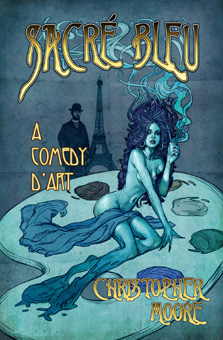

By Sarah Herrin
Thursday Review Contributing Writer
Christopher Moore’s Sacre Bleu is an amusing look at the mystery of Vincent Van Gogh's death. Moore writes at a pace that keeps the pages turning, while at the same time throwing in bits of art history to makes it obvious he's done his research. He fleshes out the speculative characters of famous painters Henri Toulouse-Letrec and Lucien Lessard as they search for clues concerning their friend's sudden death. The story also follows a young painter and the mysterious girl who offers to pose for his paintings. With Moore's wit and amazing grasp of language both modern and classic, the story will grab the reader from the very beginning.
This is the story about the color blue, a color, in ancient times that was prized more than gold, and even rarer. In between chapters of flourishing half-fiction half-history, Moore sprinkles in bits of knowledge about this color—why it was revered in art, why is was so rare to behold, and why it held painters captive. He explores the religious, cultural, and aesthetic connotations of the color. “Blue, she is like a woman,” Moore says in the prelude and thus sets the mysterious, seductive tone of his story.
The journey begins in southern France with Vincent Van Gogh’s bloody death in a wheat field and we are introduced to the mysterious Colorman for the first time. Later, in 1890 Paris, Montmartre Arrondisement, young painter-baker Lucien Lessard meets and falls in love with a young woman appropriately named Julliette. This meeting sets into motion a series of events—which has already begun for the other painters—which could very well lead to Lucien’s demise.
As all great stories are about women and the men who love them, Moore’s book makes his mark among them; however, this is not primarily a love story, but a mystery with which Moore has filled in all the (speculative) blanks in the lives of the great Impressionists. Throughout this journey, we follow the day-to-day lives of Henri de Toulouse-Lautrec and Lucien Lessard and meet such distinguished painters as Auguste Renoir, Edouard Manet, and a handful of semi-distinguished prostitutes. To one who has visited Paris, it will be a delightful return to the endearing neighborhoods of Pigalle and Montmartre.
Moore’s prose is tongue-in-cheek, matter-of-fact, and his humor keeps the pages turning. He cleverly weaves historical fiction with a slice of the supernatural and a few well-founded facts. In this story of murder, beautiful paintings, and beautiful girls, one is sure to have a wonderful time.
A chapter guide and a preview of the first two chapters can be found at Moore’s blog: http://www.sacrebleu.info/2011/12/24/sacre-bleu-the-holiday-preview/